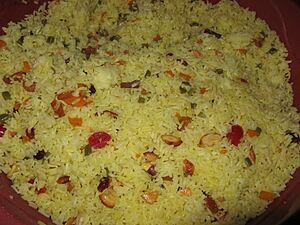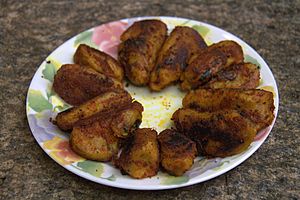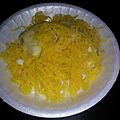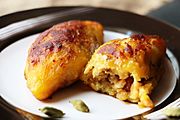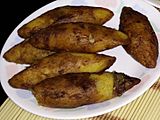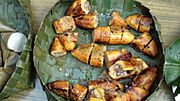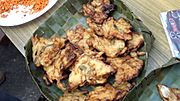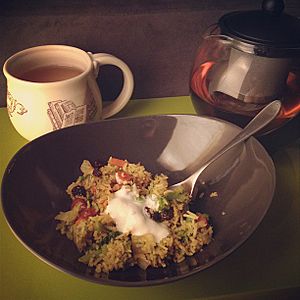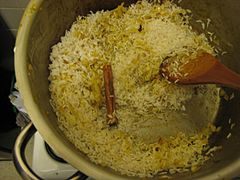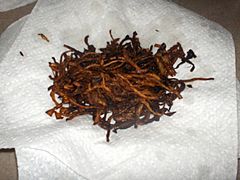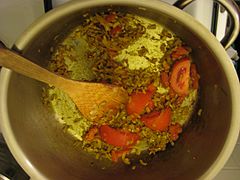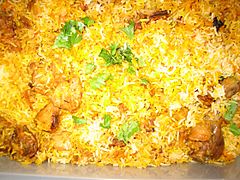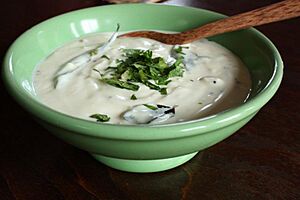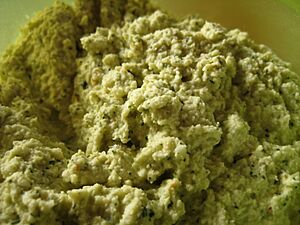Thalassery cuisine facts for kids
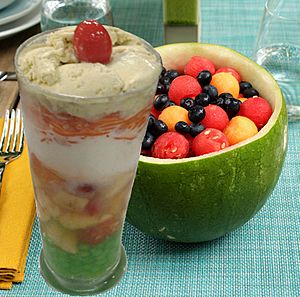
Thalassery Faloodha
|
|
| Alternative names | Thalassery biriyani or biriani (or biryani) |
|---|---|
| Course | Main course |
| Place of origin | Indian subcontinent |
| Region or state | Kerala |
| Created by | Malabar variant, Mughal inception |
| Main ingredients | Kaima/Jeerakasala rice, chicken, spices |
| 250 kcal (1047 kJ) | |
| Other information | Accompaniments: raita, grated coconut, mint chutney, pickle |
Thalassery cuisine is a special kind of food from the town of Thalassery in northern Kerala, India. It's a mix of cooking styles from Arabian, Persian, Indian, and European cultures. This happened because Thalassery was an important trading port for a long time.
Thalassery is famous for its biryani, which locals call biri-yaa-ni. Unlike other biryani dishes, Thalassery biryani uses a special kind of aromatic rice called kaima or jeerakasala. Most other biryanis use basmati rice.
You can see the influence of Arab and Mughal cultures in many dishes, especially those made by the Muslim community. These foods are now popular with everyone.
Thalassery also played a big part in Kerala's modern history of bakeries. The first bakery opened here in 1880, and Western-style cakes were first introduced in 1883.
Contents
What is Malabar Cuisine?

In Kerala, there are two main types of non-vegetarian food. One is Malabar cuisine, from North Kerala. The other is Syrian-Christian cuisine, from the South (the Travancore and Kochi areas).
These two styles are quite different. Malabar cuisine has influences from Mughlai-Arab, Portuguese, British, Dutch, and French cooking. Syrian-Christian cuisine mixes traditional Kerala dishes, which use a lot of coconut, with recipes from Syrian, Jewish, Dutch, Portuguese, and British backgrounds.
Many Malabar dishes, like Thalassery biryani, are cooked by frying them in ghee (clarified butter).
Malabar cuisine has both sweet and spicy dishes. Most of them are non-vegetarian. Some examples include ari pathiri, chatti pathiri, coin porottas, kallummakaya (mussels) fry, arikkadukka (stuffed fried mussels), and biryanis made with chicken, mutton, prawns, fish, and egg. Sweet snacks like aleesa and Kadalapparippu ada are often eaten in the afternoon or early evening.
Biryani came to this region because of Islamic influence. Over time, the recipe changed and became what we now know as Thalassery biryani. Traditionally, biryani was served only on special occasions, not as an everyday meal.
Thalassery Faloodha: A Sweet Treat
Thalassery faloodha is a local version of a Persian dessert. It's a delicious mix of fruit salad, dried fruits like blackcurrant, pistachio, cashew, and almond (badam). It also has rose milk and vanilla ice cream.
Delicious Green Mussel Dishes
Green mussels are very popular in Thalassery dishes. The Asian green mussel (Perna viridis) is called Kallu-mma-kaya (which means "fruit on the stone") or kadukka locally. They grow on rocks along the seashore.
Other mussel dishes include kallummakaya porichathu (fried mussel), arikkadukka (mussels stuffed with rice, steamed, and then fried), kallumakkaya ularthiyath (mussel stir-fry), and kallumakkaya varattiyathu (mussel pickles). Elambakka (clams) are also well-liked.
Because green mussels are so popular, farmers have started using aquaculture in local rivers to grow more of them. People from Thalassery are known for being very welcoming to their guests.
Tasty Thalassery Snacks
Another special Thalassery snack is kozhi-kkalu, made from sliced tapioca. Pappadam-pazham kuzhakkal and aval um poriyum kuzhakkal are also popular.
Other local snacks include {{transl|ml|[[Fios de ovos|Muttamala]}}, taripola, {{transl|ml|[[Banana fritter|pazham nirachatu]}} (fried banana filled with grated coconut and sugar or jaggery), {{transl|ml|[[Unnakai|unnakaya]}}, jaayi pola, {{transl|ml|[[chatti pathiri]}}, and {{transl|ml|[[Pathiri|ari pathiri]}}.
Porridges like mutaari kachiyatu (ragi porridge) are also common.
Muttamala and muttasirka are traditional sweets made with egg. Muttamala is yellow and looks like noodles, made from egg yolk. Muttasirka is white and made from egg whites. Usually, muttamala is spread over pieces of muttasirka and decorated with cherries.
Unnakkai (ഉന്നക്കായ്), also known as unnakaya or unnakka, is a sweet dessert shaped like a spindle. It's made from plantains. This famous Malabar snack is often served at weddings, Iftar parties, and other celebrations. It's prepared by stuffing plantain with flavored coconut (and sometimes egg) and then frying it in ghee.
Chatti pathiri is similar to lasagne. It has layers of spiced beef or chicken mixture placed between layers of egg-dipped pancakes. Then it's baked in an oven. It's especially served at Malabar Muslim weddings and parties.
Thalassery Biryani: A Special Dish
Thalassery biryani is a rice dish mixed with spices and chicken. It's the only biryani recipe in Kerala cuisine, so it's sometimes called Kerala biryani. Thalassery biryani is unique in Kerala because it uses Kaima rice for cooking.
Other types of biryani that use the same rice and similar cooking methods, but have slight differences in ingredients, include kannur biriyani, malappuram biriyani, ponnani biriyani, kochi kayees biriyani, calicut biriyani, kochi mint biriyani, and alapuzha biriyani.
The main difference between Thalassery biryani and other biryanis is the rice. It uses only Khaima or Jeerakasala rice. This is a short-grain, thin, and aromatic rice, also known as biryani rice in Kerala. It does not use basmati rice.
Biryani originally came from Mughal cooking. However, the Thalassery version is a local recipe from Malabar. It shows how Mughal and Malabari cultures blended together. The Mughals brought biryani from Samarkand, and over time, different versions developed across India.
Thalassery biryani might have come to the region because of the influence of Muslim rulers from Mysore and Arkot.
Thalassery biryani is a symbol of the foreign influences in Malabar. It reminds us of the Mughal-Arab culture that came to North Kerala through trade for many centuries before the 1900s. Also, many locals moved to the Middle East from the 1970s onwards. The Thalassery sea port was a big center for exporting spices, where European, Arab, and Malabar cultures met.
What Does "Biryani" Mean?
The name "Thalassery biryani" comes from Thalassery, a town in the coastal Malabar region of North Kerala, India. The word "biryani" itself comes from the Persian word biryān (n) (بریان), which means "fried" or "roasted." People believe biryani was first made in the kitchens of the Mughal Emperors. Thalassery biryani is just one of many ways to make this dish. In the local language, Malayalam, it's pronounced a little differently: "biri-yaa-ni" instead of "bir-yani."
How Culture Shaped Thalassery Biryani
Thalassery biryani clearly shows the strong influence of Islamic culture in the region. This dish is a traditional part of Mappila (Malabar Muslims) or Malabar cuisine.
Stories say that Islam came to North Malabar when the last Chera Emperor Cheraman Perumal became Muslim. This happened in Mahodayapuram (Kodungallur) with the help of Malik Deenar. Later, Perumal's sister and nephew, who lived in Dharmadam (a village north of Thalassery), also became Muslim.
Perumal is thought to have left Kerala from an old area called Poyanad. This area is between Thalassery and Kannur. Perumal's nephew, Mahabali, is believed to be the first Ali Raja of the Arakkal kingdom. This was the only Muslim kingdom in Kerala, and it controlled Dharmadam until Kerala state was formed in 1956.
These historical events show how important Islamic culture became in Thalassery.
In olden times, Thalassery was a seaport in North Malabar. It was a meeting point for three regions: Chirakkal, Kottayam, and Kadathanad. It was also the end of the "Perya pass," which came from the hilly areas of Coorg and Wayanad. This made Thalassery a key trading center for spices in Malabar.
Arab traders, Arkot rulers, and the invasion by the Sultanate of Mysore also helped introduce and develop various Islamic cultures in the region.
During the Muslim holy month of Ramzan, many different Malabar dishes are made. The Muslim community in Malabar has different lifestyles. Traders near the coast live differently from farmers in the inland and hilly areas.
Malabar cuisine changes across the region. But now, with better communication, the differences between coastal and hilly areas are less noticeable. This has led to a mix of food cultures within the Muslim community in Malabar.
Mughlai cuisine greatly influenced Malabar recipes. Mughal dishes like biryani, kebab, and naan spread across India. These dishes use ingredients like rice, maida (flour), and wheat. They also use a lot of ghee and oils for cooking. Sweet treats were made from jaggery (unrefined sugar).
Most of these dishes are non-vegetarian, using chicken, mutton, lamb, and beef. Pork is not eaten due to religious rules. Dishes can be mild or very spicy, and they all have distinct smells.
In Islamic food culture, non-vegetarian dishes must be halal-compliant. This means they are prepared according to Muslim religious rules. Many people prefer Malabar Mappila dishes because they follow the halal method of food processing.
How Thalassery Biryani is Different

Thalassery biryani uses a special, fragrant, small-grained, thin rice called kaima or jeerakasala [ml]. Even though this rice is small, it's different from the common small rice used in many other Indian rice dishes.
Kaima/jeerakasala rice is not round like other small rice varieties, and its unique smell is another special feature. Other types of rice that could be used are jeera rice, jeerakasemba, or small Bangladeshi biryani rice.
The rice is white, short-grained, and thin. But it's the aroma of these rice varieties that makes them stand out. The recipes and cooking style of Thalassery biryani are clearly different from other biryani types.
Kaima/jeerakasala rice does not need to be soaked beforehand. Water is only used to clean it. After boiling, no water should be left in the cooking pot; it should all have evaporated. This is a big difference from other rice preparations where water is drained after cooking.
Ghee rice is mixed with masala using the dum process. This is a cooking method where the lid is sealed tightly, and hot charcoal is placed on top. The biryani masala and ghee rice are arranged in layers inside the pot. The meat is cooked with masala on a low flame. Then, it's layered with rice, and the pot's lid is sealed with maida dough or a cloth. Hot coals are then placed on top of the lid.
Thalassery biryani is a Pakki biryani. There are two main types of biryani: "Pakki" and "Kacchi". In the Pakki style, the ghee rice is added to the fully cooked chicken-masala mix and then cooked using the dum process. In the Kacchi style, the ghee rice is added to half-cooked chicken and then cooked until it's fully done, often using the dum process.
Specially prepared chicken is added to the masala dish. The chicken cooks slowly in the masala, soaking up all the flavors from the spices.
The Thalassery biryani recipe has other special features. Unlike other biryanis, it's not oily because of the dum cooking process. A unique mix of spices is added, and the kaima rice also gives it a special taste. No oil is used to cook the chicken, which is added raw into the masala mix.
What Goes into Thalassery Biryani?
For the recipe, see
- Khaima (jeerakasala) rice
- Chicken
- Onion
- Ginger
- Garlic
- Green chilli
- Lime juice
- Shallot
- Coriander leaves
- Mint leaves
- Tomato
- Ghee
- Hydrogenated vegetable oil (vanaspati)
- Coconut oil
- Edible rose water
- Curd or yoghurt
- Table salt
- Spices: Garam masala powder , Persian cumin (caraway) , mace , turmeric powder , red chili powder , black pepper powder , crushed curry leaves (optional) cinnamon , cloves , cardamom , Malabar leaf (Indian bay leaf) , Indian white poppy seed (kaskas) and for garnishing and texture saffron soaked in milk, pinch of artificial food colour, yellow or orange; and fried (coconut oil) mix of onion, cashew nuts and kismis (sultana raisins) , star anise (optional).
- Preparation
-
Step 3—Fried onions (known as bista), used for garnishing (onion is fried along with cashew nuts and sultana raisins)
What to Eat with Biryani
Common side dishes served with Thalassery biryani include coconut-mint chammandi (a type of biryani chutney), South Asian pickle, and raita. After the meal, hot lime-black tea, called sulaimani by the Muslim community, is often served. This tea adds a special taste and helps with digestion. Lime tea is a common drink after meals in the Malabar region, especially after a rice-based main course.
Fried Indian anchovy or smelt can be served as a starter. It's garnished with chopped onion, curry leaves, and lime juice. Fried chicken pieces are also sometimes served as sides or starters at parties.
Daahashamani water, a special herbal water, is often preferred for drinking with biryani. Daahashamani is an Ayurvedic medicine and a natural thirst quencher and digestive aid. It's made by mixing dry ginger , cardamom, cloves , coriander seeds, mimosa catechu , sapanwood , vetiver , puncturevine , and sandal wood. You can usually find it in local markets.
Why Thalassery Biryani is Popular
Thalassery biryani is very popular and is often served at weddings, celebrations, and parties in Malabar. It's a must-have dish for the Muslim community.
Even though sadya is the traditional food for Hindu weddings in the region, some Hindus and Christians also serve biryani. This is mainly because it's easier to prepare than other main dishes and is a complete meal, so you don't need to make extra curries.
Nutrition in Thalassery Biryani
Thalassery biryani is full of good nutrients because it's a dish made with rice and spices. It has a lot of proteins and carbohydrates, and it's also a source of minerals and vitamins. The nutritional value of the spices is mentioned in the notes.
The dish contains both unsaturated and saturated fats. You can reduce the amount of saturated fat by using less hydrogenated vegetable oil (vanaspati) and ghee.
Thalassery Biryani in Movies
The Malayalam movie Ustad Hotel is about making Malabar biryani. The film tells the story of a restaurant that specializes in authentic Malabar dishes made with traditional recipes. The movie shows customers choosing this restaurant because of its real, delicious food.
"April 2009 – We were at the first discussion meeting for Kerala Cafe in Kochi. All the directors arrived and I was meeting most of them for the first time. At lunchtime, biryani packets arrived at the table. It smelt delicious and as I helped myself I asked "where is this biryani from?",.... in two years time we’d be creating Ustad Hotel together!" – Anjali Menon about the film.
The restaurant in the movie is a famous place for food lovers because its food is based on real Malabar cuisine. The restaurant serves its main dish—Thalassery biryani—to all new customers. They love the dish so much that they always come back to this restaurant and order it again whenever they visit the city.
The film highlights how important food celebrations are in Malabar culture. Making the unique Malabar biryani the main theme of a popular movie shows just how important this dish is in the Malabar region and all over Kerala.


